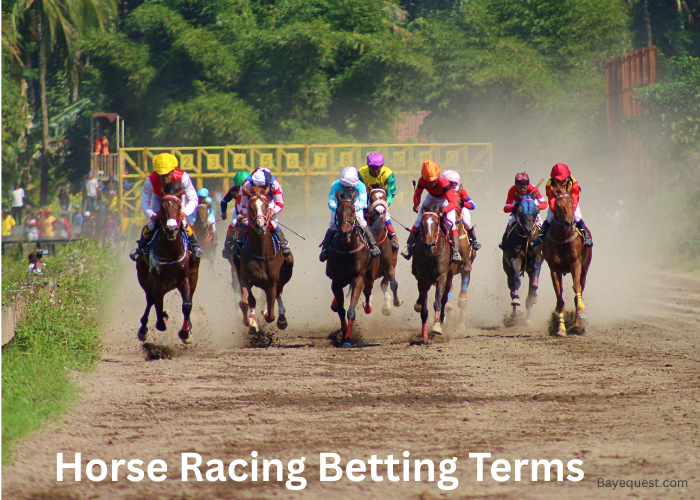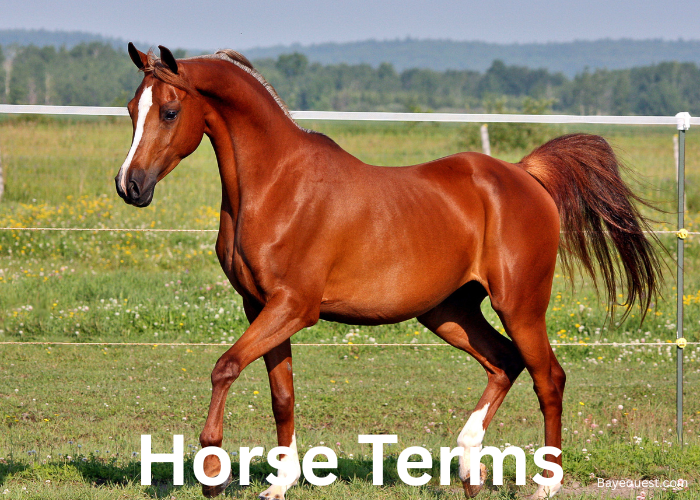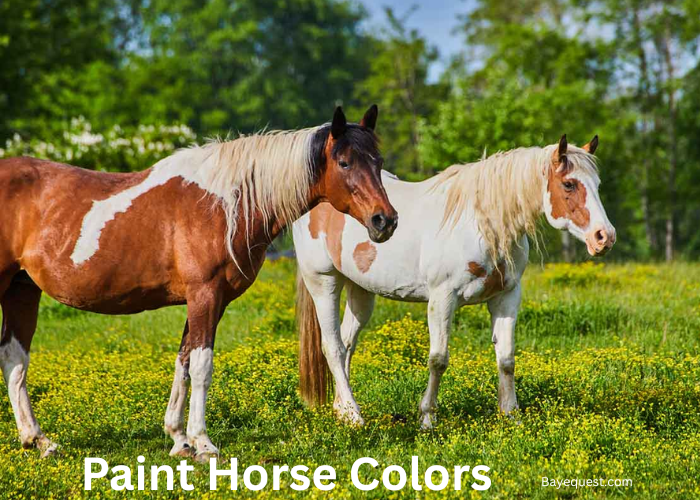Horse racing and betting have always gone hand in hand. The thrill of the race, the roar of the crowd, and the hope that your pick crosses the line first.
But if you don’t know the lingo, it can feel like stepping into a secret club with no password.
Don’t worry, you’re about to learn the terms that make betting exciting, not overwhelming.
Whether you’re aiming for a simple win or chasing a big payout, it all starts here. Let’s break it down, one bet at a time.
Why is it Important to Know Horse Racing Betting Terms?
Knowing horse racing betting terms isn’t just about sounding smart at the track. It’s about making better decisions with your money.
When you understand the basics, you can spot opportunities others miss. You know when to play it safe, when to take a risk, and when the odds are worth it.
It also saves you from simple mistakes, like thinking you’re betting to win, when you’ve actually placed a bet to show.
Plus, the more you know, the more confident and relaxed you’ll feel. And that makes the whole race day experience way more fun.
Basic Horse Racing Betting Terms
Before you start chasing big payouts, you need to master the basics. These simple betting terms are where every winning ticket begins.
Learn them first, and you’ll have a solid foundation for everything that comes next.
Win
A bet that your horse finishes first.
If it wins, you get paid. If not, you lose.
Place
Your horse must finish first or second.
It’s a safer bet than just picking a winner.
Show
Your horse needs to finish first, second, or third.
It’s even safer, but usually pays less.
Across the Board
A combination of win, place, and show bets on one horse.
If your horse wins, you collect all three payouts.
If it places second, you collect a place and show.
If it finishes third, you only collect the show payout.
Exotic Horse Racing Betting Terms
Once you’re comfortable with the basics, it’s time to level up. Exotic bets offer bigger payouts, but they also need a bit more skill.
Here’s what you need to know before you take a shot.
Exacta
You pick two horses to finish first and second in exact order.
Get the order wrong? You lose the bet.
Trifecta
You pick the top three horses in exact order.
It’s tougher to hit, but the payout is bigger.
Superfecta
You pick the first four horses in exact order.
Hard to win, but the rewards can be huge.
Quinella
Pick two horses to finish first and second in any order.
As long as they’re the top two, you win.
Daily Double
Pick the winners of two races in a row.
Usually, the first two races of the day, or a special set.
Pick 3, Pick 4, Pick 6
Pick the winners of 3, 4, or 6 races in a row.
The more races you pick, the bigger the payout.
Multi-Race Bet Terms
Think picking one winner is hard? Try picking a few in a row. Multi-race bets raise the stakes and the rewards.
Here’s a quick look at the most popular types you’ll see.
Daily Double
Pick the winners of two specific races back-to-back.
Both horses must win for you to cash in.
Pick 3
Pick the winners of three consecutive races.
All three picks must be right to win.
Pick 4
Pick the winners of four races in a row.
Harder to hit, but the payouts get bigger.
Pick 5
Pick the winners of five straight races.
Miss one, and the ticket is busted.
Pick 6
Pick six winners in a row.
It’s one of the hardest bets, but also one of the richest.
Pari-Mutuel Betting Terms
Horse racing bets aren’t set in stone. Instead, they shift based on how people are betting. That’s called pari-mutuel betting, and it’s the system behind every wager at the track.
Here’s how it works.
Pari-Mutuel Betting
All bets go into one big pool.
Winners share the pool after the track takes a cut.
Pool
The total amount of money bet on a race or a type of bet.
The bigger the pool, the bigger the possible payout.
Takeout
The percentage the track keeps from the betting pool.
It covers expenses and profits before winners get paid.
Breakage
Small rounding adjustments were made to payouts.
Instead of exact amounts, payouts are rounded down to the nearest dime or nickel.
Categories and Types of Bets
In horse racing, every bet falls into one of two main categories: Straight Bets or Exotic Bets. Each category has its own strategy, difficulty, and potential payout.
Straight bets
These are the most basic type of wager. You’re betting on a single horse to either win, place, or show. A “win” bet means your horse must finish first.
A “place” bet means your horse needs to come in first or second. A “show” bet is even safer as your horse can finish first, second, or third, and you’ll still collect a payout.
Some bettors also go “across the board,” which is a combination of win, place, and show bets on the same horse.
Straight bets are perfect for beginners because they’re simple to understand, lower in risk, and don’t require predicting the exact finishing order of multiple horses.
The downside is that the payouts are smaller, especially if you’re betting on a heavy favorite. But they offer a solid starting point for building confidence at the track.
Exotic bets
Here’s where things get more exciting and riskier. Instead of betting on one horse, you’re trying to predict the exact order of multiple horses in one race or across several races.
Bets like Exacta, Trifecta, and Superfecta require you to pick the top two, three, or four horses in the exact finishing order. Other exotic bets, like a Quinella, are a little easier since your two horses just need to finish first and second in any order.
There are also multi-race exotic bets, such as the Daily Double or the Pick 3, Pick 4, and even Pick 6, where you must predict winners across consecutive races.
The main advantage of exotic bets is the payout. They can be huge compared to straight bets.
Even a small wager can turn into a big win. However, the odds of winning are much lower, and these bets can drain your bankroll quickly if you’re not careful.
They’re best for bettors who have a little more experience and are ready to take calculated risks.
Odd Types
Odds are the heart of horse race betting. They don’t just show who’s the favorite.
They also tell you how much cash you’ll pocket if your horse comes through. But here’s the twist: odds can be shown in a few different ways, depending on where you bet.
In the U.S., Fractional Odds are the classic style. Think 3/1 or 6/5. These numbers tell you the profit compared to your bet.
So, if you see 3/1, it means for every $1 you bet, you win $3, plus you get your original dollar back. Easy enough.
But sometimes you’ll see weird ones like 9/5, which means you win $9 for every $5 wagered. It’s not rocket science, but it does take a second to get used to.
Decimal Odds are a favorite overseas, and they’re actually simpler. Instead of showing you profit separately, they show your total return.
If you bet $10 at 3.50 odds, you get $35 back. That’s your $25 profit, plus your $10 stake. Everything’s rolled into one clean number. No math headaches.
Then there’s Moneyline Odds, which show up more in regular sports betting than in horse racing.
Favorites are marked with a minus sign (like –120) and underdogs with a plus (like +250).
A –120 favorite means you’d need to bet $120 just to win $100. A +250 underdog? A $100 bet would get you $250 profit if it hits.
Moneyline odds are a bit rare at racetracks, but good to know if you dabble in multiple sports.
Each odd style has its own rhythm. Some bettors like the tradition of fractional odds.
Others prefer the simplicity of decimal odds. And if you’re switching between sports and racing, knowing how moneylines work can save you a lot of confusion.
Whichever type you see, one rule always holds: the lower the payout, the more likely the horse is expected to win. But at the track, anything can happen.
| Odd Types | Example | What it Means |
| Fractional | 5/1 | Win $5 for every $1 bet (plus your $1 back) |
| Decimal | 6.00 | Total return is 6× your bet (includes your original bet) |
| Moneyline | +400 | Win $400 profit on a $100 bet (plus your $100 back) |
| Moneyline | -150 | Bet $150 to win $100 profit (plus your $150 back) |
Race Wager Types
When you head to the track, you’re not only choosing a horse but also choosing how you want to bet and wager. It’s a small but important difference.
Bet types describe the structure of your bet, while wagers are the actual money you put down.
In race wagering, the simplest and most common bet types are Win, Place, and Show. These are all straight bets, meaning you’re focusing on a single horse’s finish.
A Win bet is exactly what it sounds like. You’re betting that your horse finishes first. If it crosses the line first, you win your wager plus profit.
It’s simple and direct, but carries a higher risk because anything can happen during a race.
A Place bet gives you a little more room. Here, your horse only needs to finish first or second.
The payouts are a bit smaller than a Win bet, but your chances of winning are higher. It’s a great middle ground if you think your horse is strong but not unbeatable.
A Show bet is even safer. Your horse needs to finish first, second, or third.
It’s easier to win, but the payout will be lower because you’re covering more outcomes. Show bets are great for cautious players or when you’re betting in races with lots of strong competitors.
Some bettors like to spread out their chances by betting across the Board. This means you’re placing a Win, Place, and Show bet on the same horse, all at once.
It costs more because you’re making three separate wagers, but it also gives you multiple ways to cash out depending on where your horse finishes.
In short:
- Your bet type decides what you’re trying to predict (win, place, show, etc.).
- Your wager is how much money you put behind that prediction.
Choosing the right race wager is about balancing risk and reward.
Common Horse Racing Jargon Related to Betting
Horse racing has its own language, and it can sound like code to new bettors. Knowing a few key terms will help you read the board, follow the action, and bet smarter.
Here’s the jargon you’ll want to know before race day.
Horse racing has its own language, and it can sound like code to new bettors. Knowing a few key terms will help you read the board, follow the action, and bet smarter.
Here’s the jargon you’ll want to know before race day.
Odds
Odds show how much you can win compared to how much you bet.
A horse with low odds is the favorite because it’s expected to win. A horse with high odds is a bigger risk but pays a lot more if it surprises everyone.
Tote board
This is the giant board you’ll see at the track. It shows real-time odds, payouts, race numbers, and results.
If the odds start changing fast, it usually means lots of last-minute betting action.
Morning line
Before the first bet is placed, the track sets early odds for each horse. That’s the morning line, a prediction of how people might bet.
Once the real money starts coming in, the odds will shift.
Favorite
The horse getting the most bets is called the favorite. It usually has the lowest odds and the lowest payout.
Favorites win a lot, but not always, which is why betting stays interesting.
Long shot
A long shot is a horse few people expect to win. It has high odds, and if it somehow wins, the payout can be huge.
Sometimes, long shots shock everyone and make for legendary races.
Paddock
Before the race, horses are saddled and walked in an area called the paddock. It’s a great place to watch how horses behave.
A calm, focused horse is usually a better bet than one acting jumpy or tired.
Scratch
If a horse is scratched, it means it’s been pulled out of the race. It could be because of injury, illness, or trainer decisions.
If you already bet on that horse, you’ll usually get your money back. Check out the impact of SCR on betting in our comprehensive guide.
Post Time
Post time is simply when the race is supposed to start. Once it’s post time, all betting shuts down, and it’s time to race.
Related read: The Importance of Post Time in Horse Racing.
Popular Betting Strategies
Smart betting isn’t just about picking winners. It’s about having a game plan.
One popular strategy is bankroll management. Set a limit before race day and stick to it.
Spreading your bets across multiple races gives you more chances to win without blowing your budget too soon.
Another move is to watch the movement of odds. If a horse’s odds drop sharply before post time, it often means smart money is coming in.
Following late shifts can reveal hidden gems that the public missed.
Some bettors also bet against the favorite. Favorites only win about one-third of the time.
Finding value in overlooked horses often leads to better payouts without needing a miracle.
Others prefer boxing exotic bets. Instead of picking the exact order, they cover every possible finishing combination among a few horses.
It costs more but boosts your chances of cashing in.
No system guarantees a win, but combining sharp observation, discipline, and smart bet sizing gives you a real edge over casual players.
How to Place a Bet
Placing a bet at the racetrack can feel intimidating the first time, but it’s actually pretty simple once you know the steps.
Here’s exactly how it works:
First, decide how much money you want to bet. Know this before you get in line so you won’t hold things up.
Next, choose the racetrack (if you’re betting remotely) and the race number. Races are numbered throughout the day, and you’ll need to specify which one you’re betting on.
After that, tell the teller your bet type.
Then, give the horse’s number, not its name. Horses are assigned numbers on the race card, and that’s what the teller needs to know to place your bet correctly.
So when you step up to the window, it should sound something like this: “Gulfstream Park, Race 4, $5 to Win on Number 6.”
They’ll confirm your bet, print your ticket, and you’re good to go. Always double-check your ticket before you leave the window.
If something looks wrong, fix it right away.
The process is almost the same whether you’re betting online or through an app. Just follow the prompts, double-check your bet slip, and hit confirm.
Important Betting Tips for Beginners
Start small: Bet low amounts until you’re confident in your picks.
Set a budget: Only gamble what you can afford to lose. Stick to it.
Understand your bets: Know exactly what you’re betting on before placing money down.
Stick to simple bets first: Focus on win, place, and show until you’re comfortable.
Watch the odds: Late shifts in odds can reveal smart money moves.
Don’t chase losses: Losing a few races is normal. Stay calm and stick to your plan.
Look beyond the favorite: Favorites lose more often than you might think. Value can hide in the second or third choices.
Study the horses: Check past performances, track conditions, and jockey records when possible.
Learn the track conditions: Some horses perform better on dry tracks, others on muddy ones.
Enjoy the experience: Winning is great, but the fun of the race is also a big part of it.
Conclusion
Horse racing is fast, thrilling, and even more fun when you understand how to bet.
Now that you know the key terms, you can walk up to the window or log in online with confidence.
Start with simple bets, keep an eye on the odds, and always bet smart. Remember, even seasoned bettors are always learning.
The more you watch, the better you’ll get at spotting winners. So pick your horse, place your bet, and enjoy the ride.
The next big win might be just one race away.







